Photos: The Monkeys of Brazil's Atlantic Forest
Muriquis on Watch
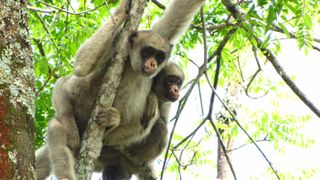
Two northern muriquis, or woolly spider monkeys (Brachyteles hypoxanthus) peer down from a tree in RPPN Feliciano Miguel Abdala, a protected reserve in southeastern Brazil. Muriquis seem resilient against a rapidly-spreading yellow fever outbreak that has affected brown howler monkeys (Alouatta guariba) and humans alike.
[Read the full story on the monkeys in Brazil's rainforest]
Baby howler
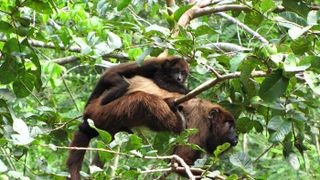
A young brown howler monkey rests on its mother's back. These monkeys depend on the forest for food, eating leaves, fruits, seeds and other vegetation. They're named for their booming territorial calls, which have been largely silenced in the RPPN Feliciano Miguel Abdala reserve by the yellow fever epidemic.
Hanging Out
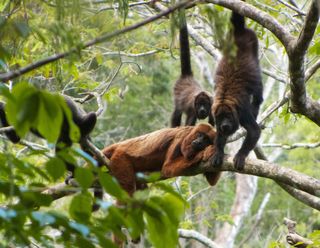
Brown howler monkeys hang out in Brazil's Atlantic Forest. A yellow fever outbreak has killed thousands of this species since late 2016, spreading rapidly despite the fragmentation of the forest that leaves the monkeys nowhere else to go.
Baby muriqui

A baby muriqui monkey and its mother at the RPPN Feliciano Miguel Abdala reserve. The reserve is the former farm of Feliciano Miquel Abdalla, who protected the forest and ultimately worked with scientists and conservationists to establish today's reserve, which covers 2,470 acres, 80 percent of which is natural forest and 20 percent is former pasture and regenerated forest. In 1983, the Caratinga Biological Station was established on the reserve, giving researchers a headquarters for studying critically endangered species like these muriquis.
Rare monkeys
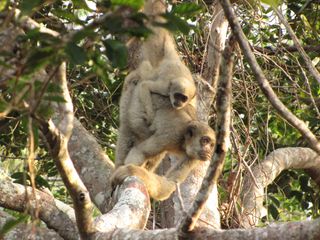
In the 1980s, the population of muriqui monkeys at the reserve dropped to only about 50. The conservation efforts of Abdala and a network of scientists and environmentalists helped boost those numbers to 340 by September 2016. According to the International Union for Conservation of Nature, there were only around 855 known muriquis in the wild as of 2005, meaning that the RPPN Feliciano Miquel Abdala reserve is home to a proportion of all muriquis.
Monkeying around
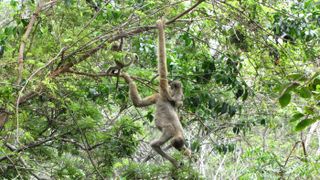
A muriqui dangles by its tail while foraging in the treetops of its forest reserve. The monkeys at RPPN Feliciano Miquel Abdala are the best-studied muriquis anywhere; they have been continuously monitored since 1982.
Last monkeys standing
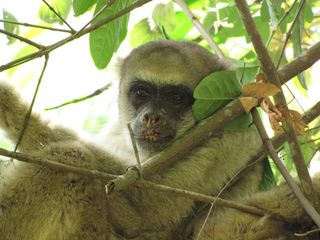
Deforestation and hunting have been the major threats to the muriqui population, according to the IUCN. Fortunately for these spider monkeys, they do not seem to be as susceptible to yellow fever as brown howler monkeys. Now researchers are eager to learn what will happen to the muriquis population and to muriquis behavior as brown howlers in the RPPN Feliciano Miquel Abdala reserve have died in large numbers.
Brown howlers
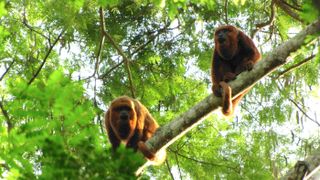
Two brown howler monkeys peer down from a branch in the RPPN Feliciano Miquel Abdala reserve. Yellow fever, carried by mosquitos, has swept through the brown howler population here, killing thousands. This image clearly displays the oversized throat structures of the brown howler, adaptations that allow them to make resonate, booming howls.
Forest sentinel
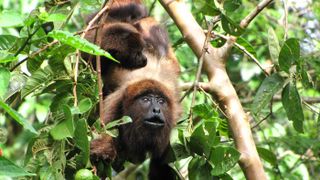
A brown howler monkey with a baby on its back peers out from the leaves in the Brazilian Atlantic Rainforest. The RPPN Feliciano Miquel Abdala reserve is a rare area where natural forest still persists; much of the surrounding area has been cleared for agriculture.
Forest morning
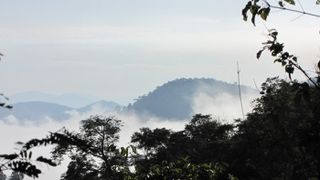
A view over the treetops of the RPPN Feliciano Miquel Abdala reserve in southeastern Brazil. This land was purchased by the farmer for which it is named in the 1960s, and the forest within was protected despite strong pressure to clear the land for timber and agriculture. Over the years, the spot has become an important refuge for wildlife and an important research station for biologists and conservationists.
Sign up for the Live Science daily newsletter now
Get the world’s most fascinating discoveries delivered straight to your inbox.

Stephanie Pappas is a contributing writer for Live Science, covering topics ranging from geoscience to archaeology to the human brain and behavior. She was previously a senior writer for Live Science but is now a freelancer based in Denver, Colorado, and regularly contributes to Scientific American and The Monitor, the monthly magazine of the American Psychological Association. Stephanie received a bachelor's degree in psychology from the University of South Carolina and a graduate certificate in science communication from the University of California, Santa Cruz.
